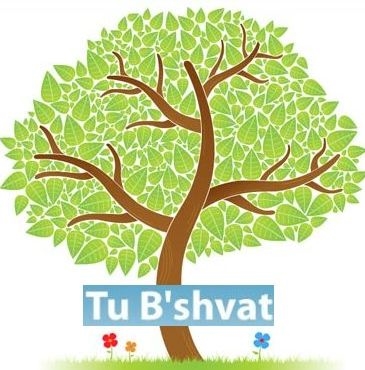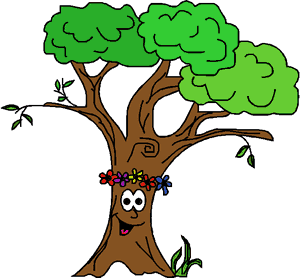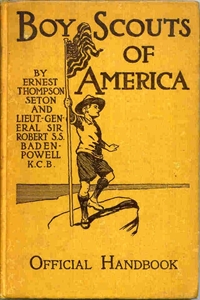Tu B'Shvat 2025 is on Saturday, February 8, 2025: The Tu B'shvat Seder
Saturday, February 8, 2025 is Tu B'Shvat 2025.
As an Amazon Associate I earn from qualifying purchases.

Here are portions of a pamphlet I wrote in 2007 to help educate the teens of my synagogue. The name of the holiday is literally the 15th of Shevat. The word “ Tu” is not really a word; it is the number 15 in Hebrew, as if you were to call the Fourth of July, “IVJuly”. (IV being 4 in Roman numerals) The 15th of Shevat was marked as the New Year for calculating the age of trees for tithing. Before the destruction of the Temple in Jerusalem in 70 C.E., ten percent of all produce was set aside for the support of the priests of the Temple and the poor. The 15th of Shevat determines the end of the “fiscal year” for trees for the purpose of tithing it’s fruit; fruit that had flowered prior to the 15th of Shevat was taxed for tithe for the previous year, fruit that blossomed after, for the following year. In the Torah (Lev. 19:23 –25) we learn that fruit from trees that were grown in the land of Israel may not be eaten during the first three years; the fourth year’s fruit is for God and after that the fruit can be eaten. Each tree is considered to have aged one year as of Tu B’Shevat no matter when in the year it is planted.
"For the Lord G-d shall lead you into the good land, a land of flowing water... The land of wheat and barley, the vine and fig and pomegranate, a land of the olive tree and honey"
Deuteronomy 8, 7-8
These seven fruits of the land of Israel are blessed in Torah: wheat, barley, grapes, figs, pomegranates, olives, and dates. It has become custom to partake of these foods to celebrate Tu B’Shevat.
There is no mention of the day Tu B’Shevat in Torah, but here in this passage in Mishnah, the only reference to it there we see, note that it wasn’t always universally marked on the 15th by all of Israel; there had been early debate:
And there are four New Year dates: - The first of Nissan - New Year for kings and festivals - The first of Ellul - New Year for animal tithes. Rabbi Elazar and Rabbi Shimon say: the first of Tishrei. - The first of Tishrei- new year for calculation of the calendar, sabbatical years and jubilees, for planting and sowing - The first of Shvat - new year for trees, according to the school of Shamai; The school of Hillel say: the fifteenth of Shvat."Mishna "Rosh Hashana", Ch.1,Mishna1
After much debate between the two schools of thought, it is apparent that the Hillel school’s observance became the custom. The reasoning mentioned for this decision was based on the conclusion that the fifteenth of the month of Shevat is the marginal date when the rains from the previous year cease to irrigate the trees and they are benefiting from the new rains.
The festival of Tu B’Shevat began in Israel, where its main customs and traditions developed. When Israel was conquered and the Jewish people went into exile, through observance of Tu B’Shevat they symbolically carried with them throughout their wanderings Eretz Israel itself and the memory of its fruits and trees The customs of Tu B’Shevat most visibly demonstrate the love of the land of Israel of the Jewish people.
In addition to partaking of the fruits of the land of Israel, the Torah gave us the custom of planting trees for Tu B’Shevat to honor the land based on this passage:
"And when you enter this land, you shall plant fruit-bearing trees..."
Leviticus 19.23
Other related passages from our sages teach: "The Holy One, blessed be He, occupied Himself with planting immediately after Creation of the world. For it is specifically written: "And the Lord G-d planted a garden in Eden". So shall you also, when you enter the land of Israel, first of all occupy yourself in planting."
Vayikra Rabba 25
“ If you have a sapling in your hand, ready to plant, and the Mosiach comes, plant the tree first and then go to greet him” - Rabbi Yochanan Ben Zakkai
Also, in ancient days, there was a custom of planting a cedar tree for a baby boy and a cypress tree for a baby girl. As the children grew, they tended the trees, and the trees grew along with the children. When they married, they often used the wood for the poles in their chuppah. This carried the tradition for loving trees from generation to generation in a concrete and loving way
Other customs arose much later to observe for Tu B’Shevat. The Kabbalistic sages of the 16th century living in Safed created a seder to celebrate the festival. They introduced new meanings and new rules of observance to “rejoice in the trees” based on Talmud and Kabbalah that related to trees and fruit. In some small degree, these new customs resembled the Passover seder with its four cups of wine. After special blessings and readings from the Torah, Talmud, and Zohar, there are four cups of wine to drink. Both red and white wine are used as follows:
The first cup is white wine, symbolizing the lifeless slumber of winter and the pale light of the moon, which is visible during the long nights of winter. The second is a glass of white wine with a small amount of red wine poured in to symbolize the awakening of creation from the slumber of winter. The third glass has more red than white to symbolize the conflict between the rains and cold and the sun and the victory of the warmth over the cold. The fourth glass is completely red wine to symbolize the explosion summer color and the warmth and strong light of the sun.
After the wine ceremony, the seder proceeds with eating of the fruits of the land, particularly the seven fruits of the land of Israel mentioned in Deuteronomy. Almonds have become a traditional food for Tu B’Shevat for in the land of Israel it is the earliest tree to blossom and often bears flowers during the time of this festival. The fruit of the carob tree (bokser) also found in Israel, is an unusual fruit that is often eaten on Tu B’Shevat.
As you eat any one of the seven fruits for which the land of Israel is blessed in Torah, perhaps in the future you may bring to mind some of the parables of our sages in ages past. In these quotes I discovered below they used them to symbolize characteristics of the Jewish people and of Torah.
Rabbi Shimon ben Lakish used to say: a people is like a cluster of grapes. Its shoots are the householders; its clusters - the sages and its leaves - the simple people. Its suckers are the idlers. It therefore follows that the clusters should pray for the welfare of the leaves, because without these, the grapes will not be sweet.
Babylonian Talmud, Tractate Chulin, 92
One who takes care of a fig tree will enjoy its fruit." Why is the Torah compared to a fig tree? Every fruit has a part which is inedible: in the date, it is the stone; in grapes, it is the pips; in the pomegranate, it is the seeds -- only the fig is entirely suitable as food."
Yalkut Shimoni, Yehoshua 1
"As the slice of the pomegranate, so is your forehead". Rabbi Shimon ben Lakish used to say, "Among your people, even the most ordinary people are filled full by the commandments, as a pomegranate. "The pomegranate trees came into blossom", these are the small children who study Torah and sit in rows before their teachers, like the seeds of a pomegranate."
Shir HaShirim Rabba 6, 17
"As the (olive) oil which acquires its superlative qualities only through being pressed, so is the people of Israel repent only through suffering. As oil brings light to the world, so shall Israel light the world."
Shir HaShirim Rabba 1
The just man as the date palm shall flourish, like the cedar of Lebanon shall he grow tall". In the same way as there is nothing wasted from the date palm, whose fronds are used for holy praise, whose dates are eaten as fruit, whose trunk provides support, whose fibres are used for rope, the threads for nets and the branches for roofing -- so the Jewish people comprises only worthy individuals: some know the Tanach, others the Mishnah, still others the Talmud; some know the Aggadah, some the commandments and others - lovingkindness.
Bereishit Rabba 41
These are all ways to celebrate and honor this festival that we can adapt to wherever we live. Tikkun Olam, correcting or perfecting the world, is also observed in the custom of planting a tree. This is a central concept in Judaism that not only promotes social justice, but environmental responsibility, and an appreciation of our place in the world as stewards of all life. Since it is customary to plant trees, Israeli school children plant trees on this day, and many Jewish children around the world collect money to send to the Jewish National Fund in Israel for this purpose. Tu B’Shevat has become a day of environmental awareness for Jewish children in Israel and in the United States, where children and families often purchase certificates for planting trees from the Jewish National Fund in honor or memory of friends and loved ones in addition to planting trees in their own communities.
We can help repair and restore our part of the world right here demonstrating Tikkun Olam for the next generation. We can teach a love of trees to our children in a concrete way in having them help us plant trees. We can plant trees to honor them or as a memorial for a loved one that they help care for and watch grow as they do. While these things may not directly relate to the original meaning of the new year of the trees for tithes of the fruits of the trees, it directly relates to giving back to God in our appreciation and the love of the earth and commandments related to the land in Torah. It also honors the duty each of us has to our descendents:
"The Holy One, Blessed be He, said to the Jews: even if you see that it is filled with every good thing, you shall not say: I shall settle, but will not plant, - and you shall not be negligent in planting... When you enter the land, you will find trees planted by other people. So shall you plant trees for your descendants.

What is the meaning of Tu b'Shevat?
The following article I wrote to share with the youth and families of my own small Jewish community last year for Tu B'Shevat Of course the quotes are not my own words and there are passages I've paraphrased from perhaps dozens of resources I've read over the decades. I've looked at a number of pages on the Internet and none of them fit what I was looking for to present to my own child, so I wrote this with him in mind and then figured it might be of help to others.
TuB’Shevat – The New Year Of the Trees
What exactly does Tu B’Shevat, the New Year of the Trees mean? Does this mean that we as Jews celebrate birthdays for trees? Do we think trees celebrate holidays of their own? Do we count the years by the trees?
Here we shall explore just what Tu B’ Shevat means, how it all started, and some of the ways this holiday has changed over history within Judaism. While there have been changes in how it is observed and what we do to mark this time, over the years the focus of Tikkun Olam, or Repair of the World can be found in each age and way of celebration. It can connect you to our past, the future, each other, the land we live in here in Arkansas, the land of Eretz Yisrael, and our lives here as Jews in an example of living as a light unto the nations.
The name of the holiday is literally the 15th of Shevat. The word “ Tu” is not really a word; it is the number 15 in Hebrew, as if you were to call the Fourth of July, “IVJuly”. (IV being 4 in Roman numerals) The 15th of Shevat was marked as the New Year for calculating the age of trees for tithing. Before the destruction of the Temple in Jerusalem in 70 C.E., ten percent of all produce was set aside for the support of the priests of the Temple and the poor. The 15th of Shevat determines the end of the “fiscal year” for trees for the purpose of tithing it’s fruit; fruit that had flowered prior to the 15th of Shevat was taxed for tithe for the previous year, fruit that blossomed after, for the following year. In the Torah (Lev. 19:23 –25) we learn that fruit from trees that were grown in the land of Israel may not be eaten during the first three years; the fourth year’s fruit is for God and after that the fruit can be eaten. Each tree is considered to have aged one year as of Tu B’Shevat no matter when in the year it is planted.
"For the Lord G-d shall lead you into the good land, a land of flowing water... The land of wheat and barley, the vine and fig and pomegranate, a land of the olive tree and honey"
Deuteronomy 8, 7-8
These seven fruits of the land of Israel are blessed in Torah: wheat, barley, grapes, figs, pomegranates, olives, and dates. It has become custom to partake of these foods to celebrate Tu B’Shevat.
There is no mention of the day Tu B’Shevat in Torah, but here in this passage in Mishnah, the only reference to it there we see, note that it wasn’t always universally marked on the 15th by all of Israel; there had been early debate:
And there are four New Year dates: - The first of Nissan - New Year for kings and festivals - The first of Ellul - New Year for animal tithes. Rabbi Elazar and Rabbi Shimon say: the first of Tishrei. - The first of Tishrei- new year for calculation of the calendar, sabbatical years and jubilees, for planting and sowing - The first of Shvat - new year for trees, according to the school of Shamai;
The school of Hillel say: the fifteenth of Shvat."
Mishna "Rosh Hashana", Ch.1, Mishna 1
After much debate between the two schools of thought, it is apparent that the Hillel school’s observance became the custom. The reasoning mentioned for this decision was based on the conclusion that the fifteenth of the month of Shevat is the marginal date when the rains from the previous year cease to irrigate the trees and they are benefiting from the new rains.
The festival of Tu B’Shevat began in Israel, where its main customs and traditions developed. When Israel was conquered and the Jewish people went into exile, through observance of Tu B’Shevat they symbolically carried with them throughout their wanderings Eretz Israel itself and the memory of its fruits and trees The customs of Tu B’Shevat most visibly demonstrate the love of the land of Israel of the Jewish people.
In addition to partaking of the fruits of the land of Israel, the Torah gave us the custom of planting trees for Tu B’Shevat to honor the land based on this passage:
"And when you enter this land, you shall plant fruit-bearing trees..."
Leviticus 19.23
Other related passages from our sages teach: "The Holy One, blessed be He, occupied Himself with planting immediately after Creation of the world. For it is specifically written: "And the Lord G-d planted a garden in Eden". So shall you also, when you enter the land of Israel, first of all occupy yourself in planting."
Vayikra Rabba 25
“ If you have a sapling in your hand, ready to plant, and the Mosiach comes, plant the tree first and then go to greet him” - Rabbi Yochanan Ben Zakkai
Also, in ancient days, there was a custom of planting a cedar tree for a baby boy and a cypress tree for a baby girl. As the children grew, they tended the trees, and the trees grew along with the children. When they married, they often used the wood for the poles in their chuppah. This carried the tradition for loving trees from generation to generation in a concrete and loving way.
Other customs arose much later to observe for Tu B’Shevat. The Kabbalistic sages of the 16th century living in Safed created a seder to celebrate the festival. They introduced new meanings and new rules of observance to “rejoice in the trees” based on Talmud and Kabbalah that related to trees and fruit. In some small degree, these new customs resembled the Passover seder with its four cups of wine. After special blessings and readings from the Torah, Talmud, and Zohar, there are four cups of wine to drink. Both red and white wine are used as follows:
The first cup is white wine, symbolizing the lifeless slumber of winter and the pale light of the moon, which is visible during the long nights of winter. The second is a glass of white wine with a small amount of red wine poured in to symbolize the awakening of creation from the slumber of winter. The third glass has more red than white to symbolize the conflict between the rains and cold and the sun and the victory of the warmth over the cold. The fourth glass is completely red wine to symbolize the explosion summer color and the warmth and strong light of the sun.
After the wine ceremony, the seder proceeds with eating of the fruits of the land, particularly the seven fruits of the land of Israel mentioned in Deuteronomy. Almonds have become a traditional food for Tu B’Shevat for in the land of Israel it is the earliest tree to blossom and often bears flowers during the time of this festival. The fruit of the carob tree (bokser) also found in Israel, is an unusual fruit that is often eaten on Tu B’Shevat.
As you eat any one of the seven fruits for which the land of Israel is blessed in Torah, perhaps in the future you may bring to mind some of the parables of our sages in ages past. In these quotes I discovered below they used them to symbolize characteristics of the Jewish people and of Torah.
Rabbi Shimon ben Lakish used to say: a people is like a cluster of grapes. Its shoots are the householders; its clusters - the sages and its leaves - the simple people. Its suckers are the idlers. It therefore follows that the clusters should pray for the welfare of the leaves, because without these, the grapes will not be sweet.
Babylonian Talmud, Tractate Chulin, 92
One who takes care of a fig tree will enjoy its fruit." Why is the Torah compared to a fig tree? Every fruit has a part which is inedible: in the date, it is the stone; in grapes, it is the pips; in the pomegranate, it is the seeds -- only the fig is entirely suitable as food."
Yalkut Shimoni, Yehoshua 1
"As the slice of the pomegranate, so is your forehead". Rabbi Shimon ben Lakish used to say, "Among your people, even the most ordinary people are filled full by the commandments, as a pomegranate. "The pomegranate trees came into blossom", these are the small children who study Torah and sit in rows before their teachers, like the seeds of a pomegranate."
Shir HaShirim Rabba 6, 17
"As the (olive) oil which acquires its superlative qualities only through being pressed, so is the people of Israel repent only through suffering. As oil brings light to the world, so shall Israel light the world."
Shir HaShirim Rabba 1
The just man as the date palm shall flourish, like the cedar of Lebanon shall he grow tall". In the same way as there is nothing wasted from the date palm, whose fronds are used for holy praise, whose dates are eaten as fruit, whose trunk provides support, whose fibres are used for rope, the threads for nets and the branches for roofing -- so the Jewish people comprises only worthy individuals: some know the Tanach, others the Mishnah, still others the Talmud; some know the Aggadah, some the commandments and others - lovingkindness.
Bereishit Rabba 41
These are all ways to celebrate and honor this festival that we can adapt to wherever we live. Tikkun Olam, correcting or perfecting the world, is also observed in the custom of planting a tree. This is a central concept in Judaism that not only promotes social justice, but environmental responsibility, and an appreciation of our place in the world as stewards of all life. Since it is customary to plant trees, Israeli school children plant trees on this day, and many Jewish children around the world collect money to send to the Jewish National Fund in Israel for this purpose. Tu B’Shevat has become a day of environmental awareness for Jewish children in Israel and in the United States, where children and families often purchase certificates for planting trees from the Jewish National Fund in honor or memory of friends and loved ones in addition to planting trees in their own communities. One may plant a tree through JNF on the Internet at .
Here, in Arkansas we are blessed to live amid a geologically and environmentally unique historic forested area known as the Ouachita Mountains. The Ouachita National Forest is the south’s oldest and largest national forest covering 1.76 million acres. In 1991, it was listed by the National Forest Protection Alliance as the second most endangered forest habitat within the United States related to logging, roads, and watershed degradation. While the population grows here, more and more trees are cut to allow for homes, businesses, and roads. Generations of families have made their livelihoods from forestry and timber harvests in Arkansas. Often lands that are cleared are not replanted in a timely manner or have the traditionally diverse mixed forests replaced with monoculture tree farming. We can use Tu B’Shevat to learn how to help protect the health of the environment surrounding and nurturing us by learning what trees we can plant here to benefit wildlife, the soil, the air and what will grow suitably in the area. We can learn how to help live in greater harmony with our habitat and surroundings and share the fruits of this land with other creatures dwelling in it while still using the bounty of this land. We can help repair and restore our part of the world right here demonstrating Tikkun Olam for the next generation. We can teach a love of trees to our children in a concrete way in having them help us plant trees. We can plant trees to honor them or as a memorial for a loved one that they help care for and watch grow as they do. While these things may not directly relate to the original meaning of the new year of the trees for tithes of the fruits of the trees, it directly relates to giving back to God in our appreciation and the love of the earth and commandments related to the land in Torah. It also honors the duty each of us has to our descendents as expressed here by passages from our sages:
"The Holy One, Blessed be He, said to the Jews: even if you see that it is filled with every good thing, you shall not say: I shall settle, but will not plant, - and you shall not be negligent in planting... When you enter the land, you will find trees planted by other people. So shall you plant trees for your descendants. And let no-one say: I am already old, how much longer shall I live? Why should I strive on behalf of others, if tomorrow I may die? Therefore a person may not evade this duty, even if he plants trees in old age, to add to what has already been planted"
Midrash Tanchuma, Kedoshim
Here is another excerpt from a Midrash teaching our social responsibility:
From Tractate Ta’anit, 23
Once, Honi HaMa'agal was walking along a road and saw a man planting a carob tree. He asked him, "How many years will it take till the tree bears fruit?"
"Seventy years", came the reply.
So he asked, "Are you sure that you will be alive in seventy years' time to enjoy the fruits of this tree?"
Came the reply, "When I arrived in this world, I found a carob tree, planted for me by my fathers, as I plant this one for my children."
In recent decades, Tu B’Shevat has been called “ The Jewish Arbor Day” or “ The Jewish Earth Day”. In a time when the ground in the land of Israel thaws and the trees begin to drink anew the water from the soil in preparation of spring, we can relate here in Arkansas by observing and embracing the cycles of nature all around us.
This festival above all others may help to connect you to our place in the world, to understanding and living Tikkun Olam in deeds to the earth itself. Each year through planting trees and watching them grow, sharing with others a path of learning how to live in harmony with nature, the deepening awareness may also grow of how each of you are connected to the past and present as Jews. As the early pioneers of the modern State of Israel planted trees to help restore the land there in generations past and continue that tradition today, we can do that here, now, whenever, and wherever we see land that needs restoring. Planting a tree in your own yard, in that of a willing neighbor, in a park or in a vacant field that may one day feed and shelter wildlife are activities we can do to celebrate this time. Each of those acts honor a day that has grown from marking a fiscal year for tithing purposes to embracing a Jewish commitment to repairing and restoring the world.
Some sources from the Internet for information found here for further reading:
mama_pajama_1 © 2007

There was a blog about holidays in February, no mention of Tu B'Shvat?
Possibly because many of us have never heard of that holiday.
I'd love to learn more about it...can you elaborate, and/or send me an email? What culture celebrates this day? What is the meaning behind it?
Is it appropriate to say Happy Tu B'Shvat?













